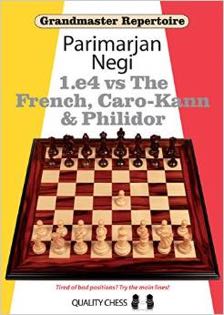1.e4 vs The French, Caro-Kann & Philidor
Parimarjan Negi

The great surprise of the 2014 Chess Olympiad was not China taking first or Hungary placing second, but India taking third. Popular thought going in was that India with all its top players would have been a contender, but without Anand and Harikrishna the best they could hope for was finishing in the top 15. After all they were seeded 19th going in.
Confounding the critics the Indians medaled. GMs Sethuraman and Sasikiran were the top performers with performance ratings of 2757 and 2753, but the undisputed hero of the team was 21-year-old Parimarjan Negi. Playing first board he scored an impressive 6.5 out of ten (PR 2730), losing only as Black to Caruana. This was quite a swansong for Negi who will be taking a break from top-level chess the next few years as he studies at Stanford.
As a parting gift before he begins his academic studies, Negi has left us a wonderful series devoted to building a repertoire behind 1.e4. Quality Chess has produced many fine opening books, but 1.e4 vs. THE FRENCH, CARO-KANN & PHILIDOR might arguably be the best one so far.
The first volume in Negis series, as the title implies, revolves around the French and Caro Kann with 3.Nc3 versus the former and 3.Nd2 against the latter. The index below gives a good idea of the lines that are covered and the amount of space allotted.
French Defence
1 Rare 3rd Moves 9
2 3…dxe4 Rare 4th Moves 24
French Rubinstein
3 Introduction 35
4 6…c5 55
French Steinitz
5 Rare Lines 70
6 7…Qb6 81
7 Sidelines with …Be7 101
8 7…Be7 8.Qd2 0-0 112
9 7…a6 139
10 7…cxd4 Introduction and 8…Qb6 153
11 8…Bc5 172
French Winawer
12 4…b6 195
13 5…cxd4 and 5…Ba5 212
14 6…Qc7 225
15 6…Qa5 240
16 Rare 7th Moves 257
17 7…0-0 and 8…f5 268
18 8…Qa5 and 8…Nbc6 285
19 13…Bd7 and 13…Qf7 303
20 Poisoned Pawn 7…Nbc6 and 7…cxd4 325
21 Poisoned Pawn 7…Qc7 338
Caro-Kann
22 3rd & 4th Move Alternatives 360
23 4…Nd7 Introduction 375
24 4…Nd7 Main Line 391
25 4…Bf5 Introduction 409
26 7…e6 418
27 11…Bb4 431
28 7…Nd7 449
29 13…Qb6 459
30 13…0-0 470
31 14…Nxe4 Introduction 485
32 17…Ng4 496
33 11…Qc7 Introduction 508
34 14…Nxe4 Introduction 524
35 15…Nf6 533
Philidor
36 Minor Lines 548
37 Hanham Variation 563
Negi doesnt just regurgitate current theory. There are many interesting novelties and lots of original analysis in this volume. Here are two that quickly caught my eye:
1.e4 c6 2.d4 d5 3.Nd2 g6 4.Ngf3 Bg7 5.c3 (One of the reasons for opting for 3.Nd2 over 3.Nc3) 5… Nh6 6.Bd3 0-0 7.0-0 f6 8.Re1 Nh6 9.h4! (In preference to the normal 9.c4). Negi backs up his novelty with two pages of analysis.
1.e4 d6 2.d4 Nf6 3.Nc3 e5 4.Nf3 Nbd7 5.Bc4 Be7 6.a4 (A very precise move which does several things including anticipating Black plans based on an early Nb6 or exd4, Ne5 and c5 by preparing to keep the bishop on the a2-g8 diagonal in many lines) 6 …0-0 7.0-0 c6 (7 …a6 8.a5!? is yet another reason for Negis advocating an early a4) 8.h3!? (A cunning move taking the g4 square away from Blacks pieces in the event of exd4 and Ne5. White also retains the option of where to put his queen and rook) 8… Nxe4 (8… b6 9.Qe2! a6 10.Rd1 is the plan) 9.Nxe4 d5 and now the stunning 10.Re1!?, played in one obscure correspondence game previously, which Negi analyses to a better ending for White after two pages of detailed analyses.
What makes this book special is Negis communication with the reader. He carefully explains why he chooses one line over another and what led him to do so. This is invaluable in a 600 page heavy weight opening book which could otherwise be very boring and of use only to a few top players. As it is 1.e4 vs. THE FRENCH, CARO-KANN & PHILIDOR should appeal to a wide audience including not only 1.e4 players but also those who play the French (over 350 pages of coverage!), Caro-Kann and Philidor.
Highly Recommended
